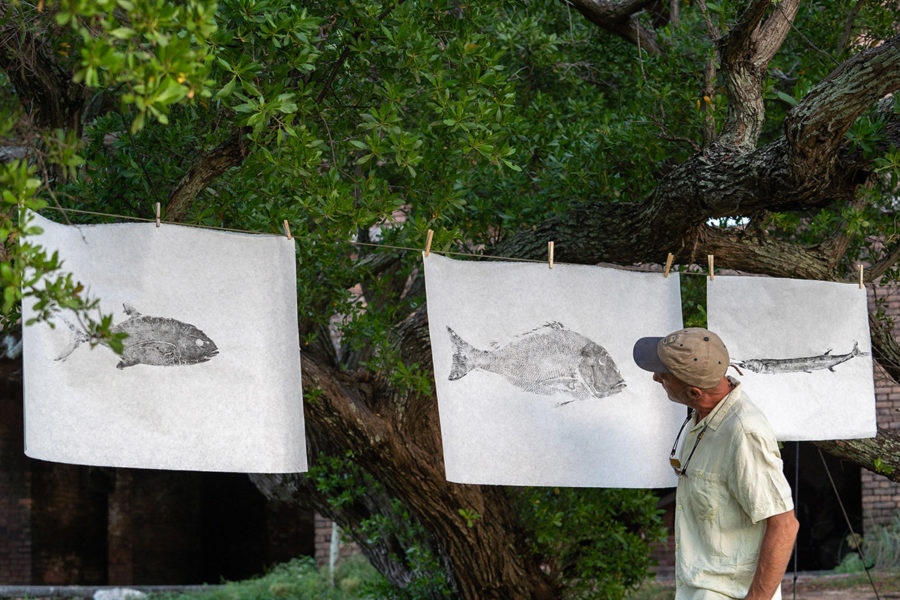
“We feel like the luckiest guys on Earth,” Austin Armstrong said. “Guys buy private islands to fish all day, and we got a taste of that.”
Armstrong, a traditional Japanese fish print artist, and conservation photographer Ian Wilson-Navarro spent all of August living on Loggerhead Key, the most remote island in the Florida Keys and the largest of seven islands that make up Dry Tortugas National Park. Both are Upper Keys natives, artists, fishermen and friends. The pair are also the most recent Artists-in-Residence at the park.
The Artist-in-Residence (AiR) program is a collaboration between National Park Arts Foundation and the National Park Service. The program aims to connect the world’s most talented artists with America’s most remote National Parks to capture and share their true beauty with others. The most recent Dry Tortugas AiR program was specifically for local artists and partially funded in collaboration with Key West Art and Historical Society. The residency, which Armstrong and Wilson-Navarro participated in, included the rare opportunity to live in the historic lighthouse keeper’s residence on Loggerhead Key to experience the park’s cultural, historical and environmental importance.

With 98% of the park being underwater, the duo focused their projects around fishing and boating — two of their favorite hobbies to enjoy in the Florida Keys. They spent their days repairing and pushing the limits of an inflatable red dinghy they brought with them, lovingly named Dorito.
The abundance and richness of the marine environment around Dry Tortugas quickly caught their attention, with “impressive size fish for native Keys species,” Armstrong said in his presentation on his final night at the park . “It is so clear that protecting natural resources like they are really good at doing in the park makes such a drastic difference from where Ian and I are from in Upper Keys. We saw it in everything, from the amount of life to the size of the fish to the health of reef.”
As for their creations, the artists showcased the rich abundance of the area in very different, but complementary, ways. Armstrong took every fish the pair caught into his care, cleaning it, painting it with black, non-toxic ink and creating a traditional-style Japanese Gyotaku print of the fish. Back in the day, this was how fishermen could capture the exact details of fish they caught “for bragging rights with their buddies,” Armstrong detailed. Now, he uses the same methods to immortalize the Dry Tortugas’ fish and create realistic, exact representations of what he and Wilson-Navarro caught and then ate.
Throughout their stay, Wilson-Navarro was rarely without his camera. With his natural freediving and fishing abilities, he captured incredible moments above and below the water, including baby sea turtles emerging from a nest and historic Fort Jefferson framed between a meteor shower and a tropical storm. His epic photographs serve as a record of what life is like on the remote islet now, and what it may have been like throughout the Keys in decades long gone.
“It was like jumping into a time machine,” the photographer said. “There are things here that I never thought I would see in my life. I am forever changed. My life will never be the same.”
Their month away from everything inspired the artists to share what they’ve learned with fellow conchs throughout the Keys. Wilson-Navarro said, “I’m passionate and driven to document the Florida Keys while it’s got this remaining life to it — especially in the Dry Tortugas. We’ve seen so much this past month; now we can go back to the Upper Keys and use our images, our art, to show people who may not know, just how far we’ve fallen away from this richness, and what we must work together to bring back.”\
Cori Convertito, museum curator for Key West Art and Historical Society said, “I’m glad we were able to find people so close to home that were the perfect candidate for this — not just dedicated to their art but to understanding the bigger picture here. They’re home-grown and understand the shifting ecosystem and why that matters.”
Introducing the artists for their final presentation, Curtis Hall, Lead Park Ranger for Interpretation, Education & Volunteers said, “These guys fully captured the essence and resources of the park. During incoming tropical storms, they were given the option to leave, …however, Ian and Austin chose to stay [because] storms and perseverance in the Tortugas were part of the history they hoped to connect with, capture and share. Our National Parks are wonderlands where we strive for balance between conservation, preservation and use. The artists certainly hit the balance perfectly,” he noted.
The artists exhibited their works at the recent Islamorada Art Walk on Sept. 16 and will continue to do so throughout the Keys in upcoming months. Wilson-Navarro, who also shoots for the Keys Weekly, is planning a coffee table book “that will live on forever and inspire action in the rest of the archipelago to bring things back.” Follow Armstong on Instagram at @armstrong_originals and Wilson-Navarro at @ianwilsonn.




























